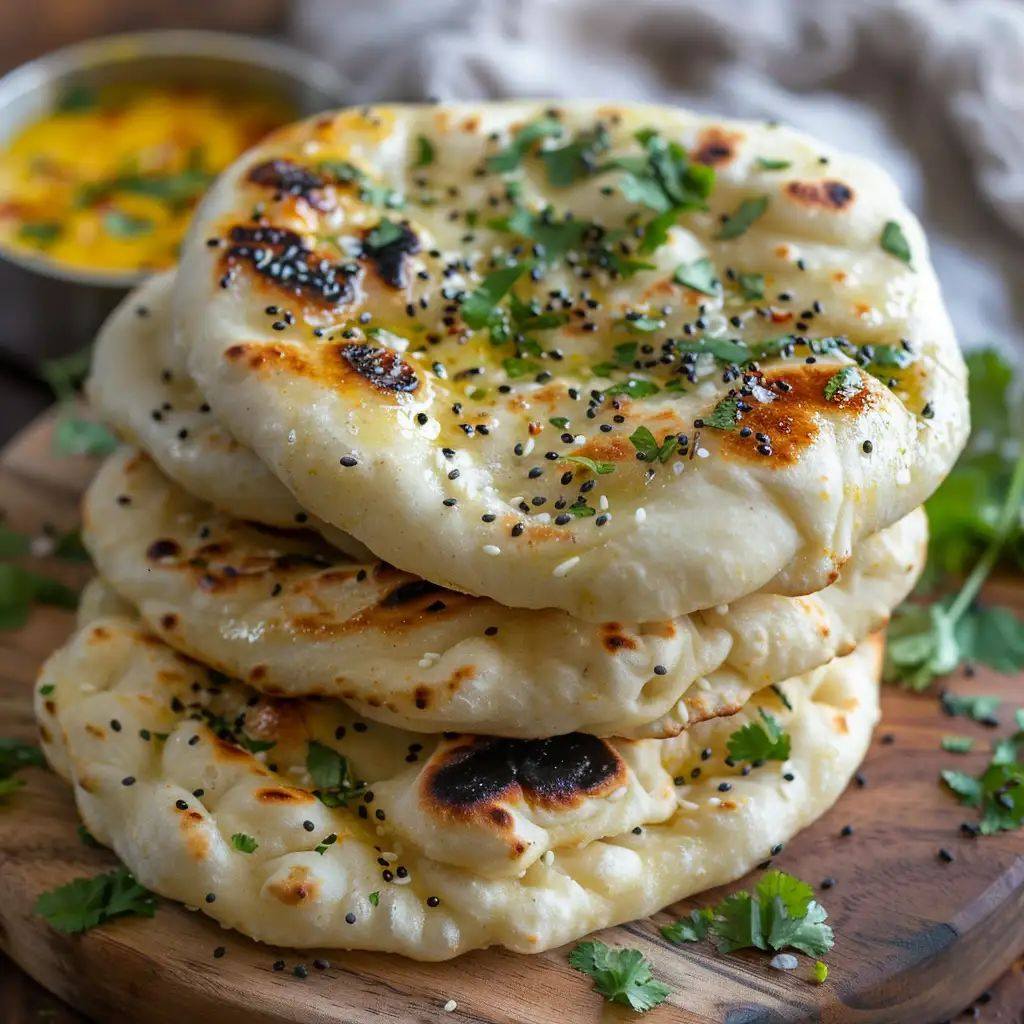ADVERTISEMENT
Instructions:
1. Activate the Yeast:
In a small bowl, combine the active dry yeast, sugar, and warm water. Stir gently and let it sit for about 5-10 minutes, or until the mixture becomes frothy. This step ensures that the yeast is activated and ready to help your dough rise.
2. Make the Dough:
In a large mixing bowl, combine the flour, salt, and baking powder (if using). Create a well in the center and pour in the yeast mixture, yogurt, olive oil (or melted butter), and milk. Stir with a wooden spoon until a sticky dough begins to form.
Once the dough starts to come together, transfer it to a clean, floured surface. Knead the dough for about 5-7 minutes, until it’s smooth and elastic. If the dough is too sticky, sprinkle a little more flour as needed, but avoid adding too much, as you want the dough to remain soft and pliable.
3. Let the Dough Rise:
Lightly oil the inside of a clean bowl and place the dough inside. Cover the bowl with a damp cloth or plastic wrap, and let the dough rise in a warm place for about 1-1.5 hours, or until it has doubled in size. If you’re short on time, you can speed up the process by placing the dough in a warm oven (turned off, but with the light on).
4. Divide and Roll the Dough:
Once the dough has risen, punch it down to release any air bubbles. Divide the dough into 8 equal portions. Roll each portion into a ball. Using a rolling pin, roll each dough ball out into a flat, oval or round shape, about 1/4 inch thick. If you want thinner naan, roll the dough out more; if you prefer thicker naan, leave it a bit thicker.
If you’re making garlic naan, now is the time to sprinkle the minced garlic on top of the rolled-out dough. Press it gently into the dough with your rolling pin.
5. Cook the Naan:
Heat a heavy skillet or cast-iron pan over medium-high heat. Once the pan is hot, place one piece of dough onto the skillet. You should hear a sizzle as it touches the pan.
Cover the pan with a lid and cook for about 1-2 minutes, or until bubbles start to form on the surface. Then, flip the naan over and cook for another 1-2 minutes until the bottom is golden brown and slightly charred. The naan should puff up during cooking, which is a sign of a great texture!
Repeat the process with the remaining dough balls, adjusting the heat as necessary to prevent burning.
6. Brush with Butter (Optional):
After removing the naan from the skillet, brush the top with melted butter or ghee (clarified butter) for added flavor and softness. If you’re making garlic naan, sprinkle chopped cilantro on top while the naan is still hot.
7. Serve:
Serve your naan warm alongside your favorite curry, stew, or grilled dish. Naan is also perfect for dipping in yogurt, hummus, or even a simple chutney.
Tips for Perfect Naan Bread:
- Use Warm Water: Make sure your water is warm (around 110°F or 43°C) but not too hot. Water that’s too hot can kill the yeast, preventing the dough from rising properly.
- Don’t Overwork the Dough: While it’s important to knead the dough enough to activate the gluten, you don’t want to overwork it. Over-kneading can lead to dense naan. A few minutes of kneading is all you need.
- Roll Evenly: Roll the dough evenly to ensure the naan cooks uniformly. It doesn’t have to be perfectly round—naan is often irregular in shape, which adds to its charm.
- High Heat Is Key: To get that signature charred, bubbly texture, make sure your skillet is very hot before adding the dough. If the pan isn’t hot enough, the naan will cook too slowly and won’t puff up properly.
- Use Ghee or Butter for Rich Flavor: Brushing your naan with ghee or melted butter after cooking adds a rich, authentic flavor. If you’re making garlic naan, the combination of garlic and butter is irresistible.
Why You’ll Love Homemade Naan Bread:
- Soft and Fluffy: The key to great naan is its soft, pillowy texture, which comes from the yeast and yogurt. It’s light and airy, but still substantial enough to hold up to all your favorite dips and curries.
- Simple Ingredients: Most of the ingredients needed for naan are pantry staples, so you can easily whip up a batch whenever the craving strikes.
- Perfect for Sharing: Naan is a great food to serve in a communal setting, whether you’re sharing it at a family dinner, a barbecue, or a potluck. Everyone can tear off a piece and enjoy it with their meal.
- Versatile: While this recipe is for classic naan, you can easily customize it by adding different herbs, spices, or toppings. Try adding cumin seeds for a fragrant twist, or sprinkle with sesame seeds for a crunchy texture.
- No Special Equipment Needed: Unlike traditional tandoor-cooked naan, this recipe can be made with a regular skillet or cast-iron pan. It’s a simple way to recreate this restaurant favorite right in your own kitchen.
Conclusion:
Homemade naan bread is one of those recipes that elevates any meal. Soft, fluffy, and slightly crispy, it’s the perfect accompaniment to curries, stews, or even grilled meats. Best of all, making naan at home is easier than you might think—and it’s a fun way to bring a taste of India (or the Middle East) to your table.
With just a few simple ingredients and a little patience, you can make naan that rivals what you’d find at your favorite restaurant. So roll up your sleeves, fire up the skillet, and enjoy a warm, homemade naan that will have everyone asking for more!
ADVERTISEMENT
